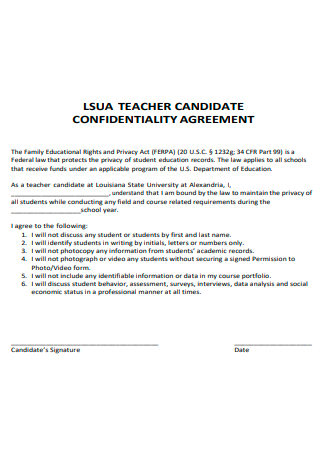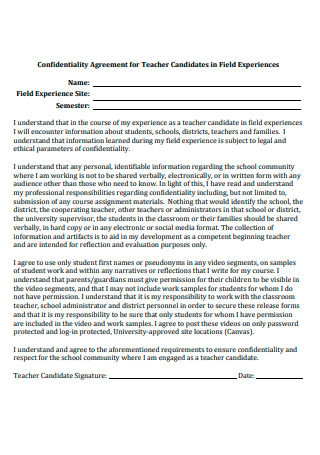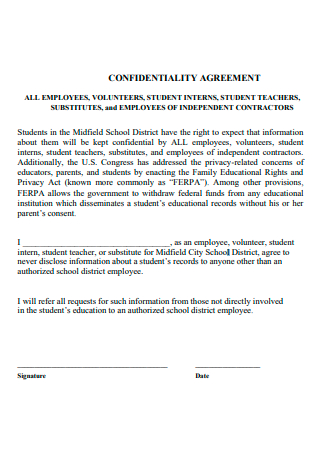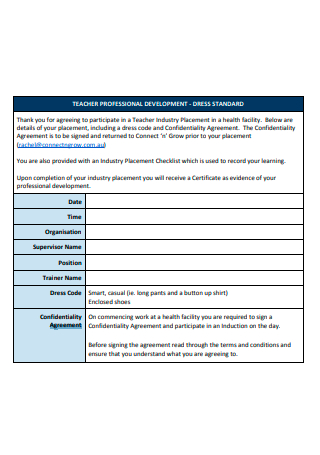3+ Sample Teacher Confidentiality Agreement
FREE Teacher Confidentiality Agreement s to Download
3+ Sample Teacher Confidentiality Agreement
What Is a Teacher Confidentiality Agreement?
What Are Ways to Make a Teacher Confidentiality Agreement Interesting to Read?
How to Write a Teacher Confidentiality Agreement that Is Easy to Understand?
What Are the Three Types of Confidentiality Agreement?
Elements Covered in a Teacher Confidentiality Agreement
How to Create a Teacher Confidentiality Agreement
FAQs
Who is responsible for the confidentiality of students’ grades?
What are the laws about confidentiality in the classroom?
What is the difference between an NDA and a Confidentiality Agreement?
What Is a Teacher Confidentiality Agreement?
The teacher confidentiality agreement is a critical component of teaching. Occasionally, this arrangement is referred to as a non-disclosure agreement or NDA. It is a corporate contract that safeguards critical firm information, products, and commerce, among other things. You will receive additional benefits from the company as a result of this agreement. This agreement may be utilized in a variety of circumstances, including interviewing and employing employees or independent contractors. As a teacher, you will find this agreement a useful instrument to utilize in the classroom and other academic institutions. This one will assist them with formulating the teacher’s performance in the classroom.
Other templates are available on our website, and you can use them whenever you need them. They are as follows: contract agreement, confidentiality agreement, real estate confidentiality agreement, non-disclosure agreement, learning contract, meeting confidentiality agreement, teacher contract, worksheet for teacher template, disclosure agreement, data confidentiality agreement, and other similar templates are available. This post will not only provide you with templates but will also provide you with important information that you need to know in order to complete your template.
What Are Ways to Make a Teacher Confidentiality Agreement Interesting to Read?
You must provide some suggestions on this teacher confidentiality agreement form in order for it to be easier to grasp for others. Because this document is a formal agreement between two parties, it will detail the confidential material, knowledge, or information that has been communicated between the two parties participating in the agreement. Third-party access to the information will be restricted as a result of this restriction. Keeping the secrecy of patent law and the protection of trade secrets in a lawful manner is essential if you wish to write about unilateral confidentiality. This one will also place restrictions on the distribution of information prior to the publication of a press release. This agreement will also cover the possibility of exposing the information to a third party.
How to Write a Teacher Confidentiality Agreement that Is Easy to Understand?
In order to make this one more fascinating to read, you should include a list of the products that are covered by this contract. Items such as grades and attitude problems should be documented in this agreement. An important element of a teacher confidentiality agreement form template is the grade level that should be specified. This one is a standard agreement that will assist the student who is struggling with their academic achievement in some way or another. In addition, you should include the difficulties related to the attitude in your agreement template. The majority of the timetable is devoted to the student’s mentality, which will prevent him or her from reaching big things, therefore you should follow the terms of the agreement to the letter.
What Are the Three Types of Confidentiality Agreement?
A confidentiality agreement restricts the access of third parties to the information included inside the agreement that is being written down in the agreement. There are three forms of confidentiality agreements: unilateral agreements, bilateral agreements, and multilateral agreements, among others. The following is a brief overview of the three types of confidentiality agreements available:
1. Agreement on Confidentiality in a Unilateral Setting
In this general agreement, it is anticipated that information will be disclosed to the other party, and it is required that the information be protected against future disclosure for a variety of reasons (i.e., maintaining the secrecy of patent laws, protection of trade secrets in a legal manner, limiting disclosure of information before a press release is announced or published, etc.).
2. Agreement on Confidentiality Between Two Parties
There are two parties involved in this arrangement, which is also known as a mutual non-disclosure agreement or a two-way non-disclosure agreement. Both parties anticipate releasing information to one another and plan to keep each other’s information from being shared with anybody else. This form of straightforward agreement is frequently used by businesses that are ready to embark on a joint venture or merger with another company.
3. Agreement on Confidentiality on a Multilateral Scale
The other type of confidentiality agreement is a multilateral confidentiality agreement that involves three or more parties in which one of the parties anticipates disclosing information to one or more of the other parties and requires that the information be kept confidential from further disclosure.
Elements Covered in a Teacher Confidentiality Agreement
When establishing a teacher confidentiality agreement, there are a few things you should consider including. In addition, depending on the type of material you wish to keep confidential, you may include further details.
How to Create a Teacher Confidentiality Agreement
Keep in mind that the purpose of this type of paper is to ensure that anybody you hire as a teacher does not divulge any material that has been designated as confidential. Whatever type of educational institution you are in charge of, it is critical that you develop this type of agreement to protect your school from information leakage, especially if that person has easy access to the information. With that in mind, the following stages will guide you through the process of creating an effective teacher confidentiality agreement:
Step 1: Create the Document’s Title
To begin, you’ll need to establish the document’s title. The apparent reason for doing so is that you want those who go through it to understand exactly what to expect. Therefore, when generating the title, ensure that it is placed at the very top of the document and has a little larger font size to separate it from the other pieces of content. Additionally, you may enjoy personal confidentiality agreements.
Step 2: Determine Who Will Be Affected by the Agreement
You must include information about who will be a part of the agreement in this section. The reason you need to identify who will be a party to the agreement is that it will come in handy if a circumstance develops where you need to prove who consented to the document’s terms and conditions.
Step 3: Indicate the Types of Information That Are Confidential
Once you’ve determined who will be included in the agreement, the following step is to specify what information the teacher must protect. The categories of information that you intend to keep confidential can include any type of information that the parties may exchange. It’s quite self-evident at this point that the documents you should mark as confidential should be those pertaining to the educational institution. Essentially, anything that you believe would be detrimental to the institution if released must stay confidential.
Step 4: Indicate the Information That Is Not Covered by the Agreement
This is often not a list of individual items, but rather broad categories of information that are essentially public and does not require security. It is critical that you identify these pieces of information so that the teachers you recruit will have an easier time evaluating what they can disclose and what must stay confidential.
Step 5: Establish the Teacher’s Duties and Responsibilities After Receiving Critical Information
Typical confidentiality agreements place restrictions on how the receiving party may utilize the sensitive information. Additionally, the agreement establishes the rules under which the teacher must maintain the confidentiality of the material. Given that we’re discussing creating a confidentiality agreement for a teacher you’ve hired, you should always consider limiting his or her ability to use it.
Step 6: Indicate the Duration of the Agreement’s Validity and Enforceability
The typical private agreement lasts approximately five years, but some last as little as two or three. You can always conduct a study to determine how long it should last in the location in which you live. Although the endpoint does not have to be a precise date, a certain date should be utilized as a starting point. That way, the instructor will know precisely when the agreement will take effect and when he or she will be prohibited from sharing the material with anybody other than those with whom they are permitted to discuss it.
If you’re interested in learning more about the numerous forms of confidentiality agreements that you can enter into, all you have to do is browse our website. It has a variety of articles that should be able to provide you with any assistance you may require. The only thing you need to do is properly study these articles in order to make optimal use of the knowledge they contain.
FAQs
Who is responsible for the confidentiality of students’ grades?
The laws clearly define the obligation to maintain the confidentiality of grades and medical records. While teachers are required to reveal student grades to parents, they are not permitted to make such results public.
What are the laws about confidentiality in the classroom?
Confidentiality in the classroom is governed by state statutes and the federal Family Educational Rights and Privacy Act (FERPA). These codes, statutes, and acts specify the types of information that instructors are required to keep confidential between themselves and their students, as well as the types of information that teachers are required to communicate to parents.
What is the difference between an NDA and a Confidentiality Agreement?
There is no distinction between a confidentiality agreement and a non-disclosure agreement. Both are legally enforceable agreements in which at least one party agrees not to disclose particular information.
A teacher confidentiality agreement is a standard contract between a teacher and a student that prohibits the teacher from releasing certain information about the student’s performance and other matters. Disclosing that information will undoubtedly have a negative effect on the student and may even drive the student to transfer schools. We hope you found this material educational and beneficial as you prepare to create your teacher confidentiality agreement.




